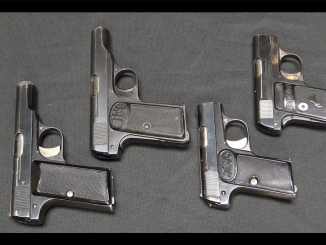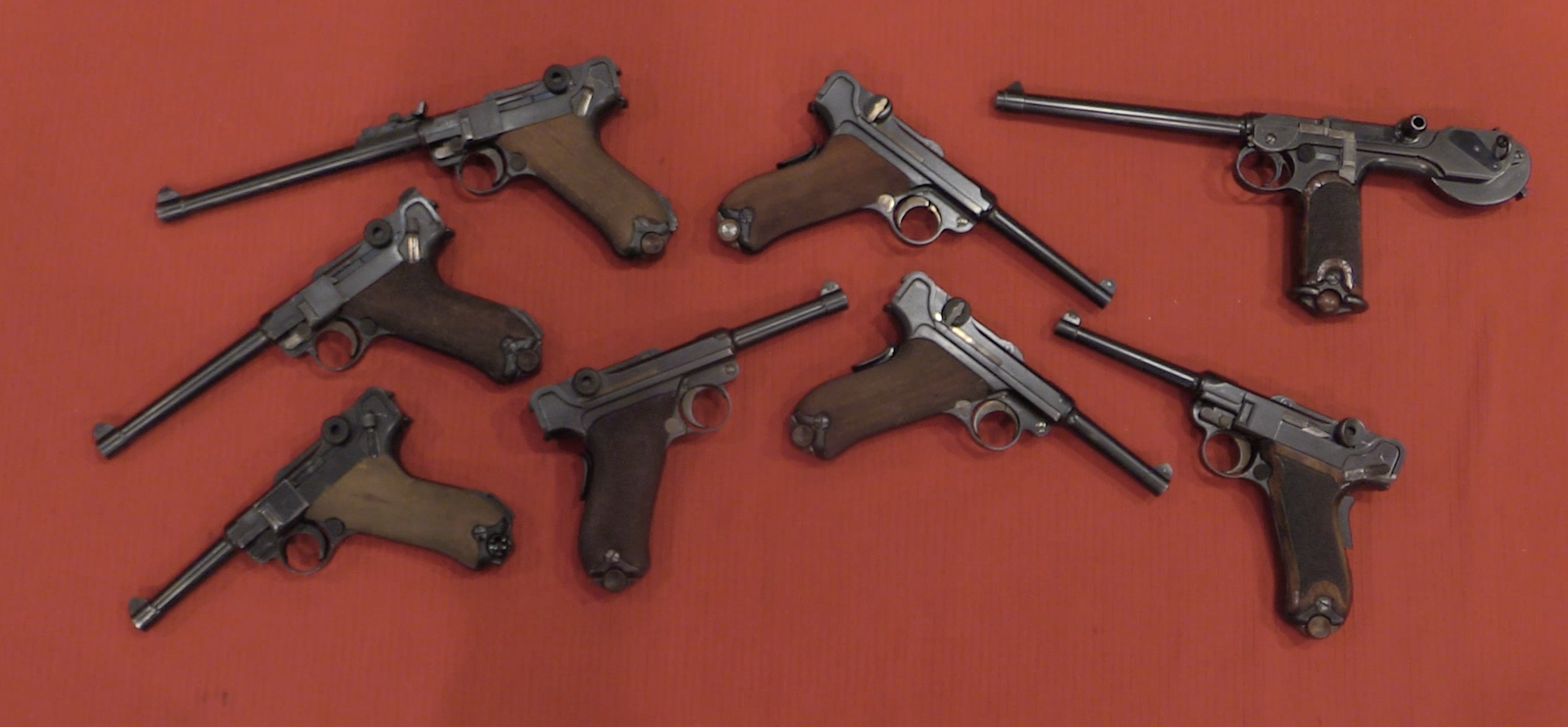This rifle is lot #2168 at Morphy’s April 2019 auction.
The Heym SR30 is a modern hunting rifle produced in Thuringia, Germany using a rather clever and interesting locking system. It is a straight-pull rifle with six ball bearings around the circumference of the bolt head. When the bolt handle it forward, it forces a central plunger down the interior of the bolt body, forcing the ball bearing out to lock into recesses in the receiver. Pull the bolt handle back, and the plunger retracts, allowing the locking bearing to retract into the bolt so it can open. This avoids the usual problem of straight pull systems having quite stiff actions when a camping system is used to translate linear motion of the bolt handle into rotary motion of the bolt head.




As of 40 minutes after this video going live there were no bids on this rifle. Wonder how much of an effect Ian will have.
Sort of a manual variant of an H&K type roller locked breech, in other words.
Back in the 1970s, Colt (briefly) marketed a turnbolt rifle with a triple flap-locking setup. When the bolt handle was turned down and the bolt was in battery, three wedge-shaped flaps swung out from the bolt head to engage three recesses in the barrel extension.
Sales weren’t great, partly due to its novelty, but I suspect mostly due to shooters not being used to seeing the Colt trademark on a rifle. Never mind that they have manufactured or marketed rifles off and on throughout their history, or that Colt was the first supplier of M16 rifles to the U.S. military, and is still the biggest manufacturer of them today.
cheers
eon
“Sort of a manual variant of an H&K type roller locked breech, in other words.”
This lead me to wondering about how well Heym SR30 system could be scaled? Said H&K system was applied to wide range of cartridge starting from 9×19 Parabellum up to 12,7×99 NATO. Certainly SR30 itself could harness some serious cartridges, like 8×68 S for example, but would scaling it up to handle even bigger cartridge be viable option?
Eon, you’re thinking of the Colt-Sauer, which was a bit of badge engineering done by Colt. The original rifle was a Sauer Model 80, and represented an attempt by Colt to get into the high-end sporting rifle market.
Same time frame, there was also the Kleingunther rifles, which were basically tuned Voere rifles brought over from the German Voere company, not the Austrian one.
I remember fondling the Sauer rifles at the Rod and Gun clubs in Germany, and when the time came for me to buy my remembrance piece, I plunked down on the Voere because I liked the fact I could get the Schwenkmontage for its scope more easily down at Frankonia Jagd. The Sauers were really nice–They had a cold hammer-forged barrel that hadn’t been machined down afterwards, and they looked really gorgeous with the faceted pattern left by the hammer-forging process, especially after the bluing was applied. Gorgeous guns.
I kinda wish I’d spent the money when the exchange rate was nice and high, and gotten both, but I wasn’t able to save up enough, and when I had the cash, the exchange rate made the prices on the Sauer too high.
Should have stuck this here:
http://www.coltsauer.com/
Colt-Sauer, yes, that was it. I couldn’t remember the “other name”.
Colt did have a .22 semi-auto rifle of their own devising back in the early 1960s, the Colteer. There were also two variant forms of it, the Courier and the Stagecoach.
Whatever they were called, they were pretty much copies of the Marlin Model 99 internally. Since there were something like six other similar .22s on the market when they were introduced, they failed to catch on.
Other than the AR-15 series, Colt has just never had much luck marketing rifles.
cheers
eon
When I was about 12 there was a liquore-and-outdoor store in my home town that had one of the Colteer stagecoach guns for sale. Dad didn’t think I was old enough for a semiauto at the time, and the store went out of that business a short time later. I got a 10/22 for my 14th birthday. I still remember that “western-look” 22 in the rack at that store. You brought back a pleasant memory.
Mone detail of this gun puzzles me: Do the ball bearings engage in an annulsr groove, into corresponding holes or into spherical dimples? In the first two cases, contact area would be minimal. In the third case, you’d have to be extremely precise in positioning and sizing the dimples.
“camping system”
Never ever heard that term before? What camp refers in this case?
“SR30”
You could read user manual here: http://deutsches-jagd-lexikon.de/images/d/da/Heymsr30.pdf
pdf contains three language versions: Deutsch, English and Français.
The first issue: he referred to a cam system, not a camp.
This indeed look like the simplest straight pull locking I have seen (and there are more than dozen at this time). Actually, it reminds me of tool quick locking in drill-press; remove drill bit and replace it with reamer in matter of seconds.
The mating piece I suppose would be a ring, pressed into receiver and backed by threaded barrel, with corresponding set of holes thru it. This system works in hunting gun, but I doubt it would be maintainable in military one.
Thanks for showing this unusual design!
“This indeed look like the simplest straight pull locking I have seen (and there are more than dozen at this time).”
1. wedge: Mannlicher M1886
2. rotating bolt: Mannlicher M1890, Smidt-Rubin, Ross
3. camming action: M1895 Lee Navy
4. ball bearing: Heym SR30
5. radial: Blaser
I am run out of knowledge. What are the other straight pull bolt actions?
https://en.wikipedia.org/wiki/List_of_straight_pull_rifles
I want to add one little-known straight-pull repeating rifle there:
https://www.thefirearmblog.com/blog/2009/01/31/newton-leverbolt-rifle-the-bolt-and-lever-rifle-has-had-a-child/
If I had to pick only one, this would be my choice
https://en.wikipedia.org/wiki/K31
There are “true” straight-pull bolt-action rifles and “faux” straight-pull bolt-action rifles. Generally, the “true” ones have bolts that do not rotate at all, like the M1886 Mannlicher or the M1895 Lee.
The “faux” variety are basic Mauser or similar pattern turn-bolt systems with the addition of a cam-path or other bolt-rotating widget operated by a separate, generally parallel, operating rod system with a handle on it. The various models of the Swiss Schmidt-Rubin straight-pull design, such as the K31, fall into this category, adding an elaborate amount of extra machinery just to avoid having to flip a bolt handle up before pulling it back, and flip it back down after shoving it forward.
Such systems add complication but little utility, and really have no place on a combat rifle.
One amusing sidelight of this is that most of the early attempts to convert bolt-action rifles to self-loading ones, like the British “Sword Guard Pattern” SMLE, ended up with the same sort of operating rod/cam-path system bolted on the side, except in their case powered by a gas-piston alongside the barrel with a gas port near the muzzle. Few of the designers seem to have wanted to fool with a muzzle gas trap, as such conversions were complicated enough with just the cam system.
cheers
eon
The SR30 is, compared to the company’s size, a fairly popular hunting rifle here in Germany. The sales numbers from my knowledge are not as high as the ones for the famous Blaser R93/R8 line of rifles.
Heym offers them in a limited range of hunting calibers from small center fire cartridges (.222 Rem) over medium (.308 or 8x57IS) to magnum cartridges (8x68S or.375Ruger).
An interesting test of what the system is able to withstand in terms of (over)pressure can be found here at the bottom of the page:
http://lutzmoeller.net/Waffen/Heym/Heym_SR30.php
I used to have an SR 30 (where btw. SR means Sicherheits-Repetierer or Safe Repeating Rifle, loosely translated). I gave it away unfortunately but now I am saving up for a lefthand version in 9,3×62, Keiler Edition with short barrel and open sights. Retail prices for right- and lefthand models are the same. On the Heym homepage you can find a lot of useful information on the rifles as well, in German, English and French.
+1
also left-hand versions, and tacticals/long-range sporters:
https://en.wikipedia.org/wiki/Blaser_R93_Tactical
and lookey here about the similar, but not identical fortner system in the anschütz 1827 biathlon rifle
https://qz.com/54254/this-german-invention-is-used-in-95-of-rifles-in-biathlons/
Looking at this Blaser R93 bolt… it look equally finicky. But it is said to be safe, so be it.
https://www.newenglandcustomgun.com/Gun_Services/item_info.asp?Brand_id=8253&ST=Blaser%20R93%20Magnum%20Bolt%20Head#.XKyXk-RYZjo
It is a pretty nice rifle. I use it for hunting.
There is no need to keep the safety off, you can put it on fire with your thumb very quickly. Just after you can cock the gun with your thumb.
If you use your index finger and support the other side of the safety with your thumb, it is silent and nearly as fast.
To keep the action very smooth, you have to keep the bolt clean and slightly oiled.
The .30-06 gun does not have the single ball bearing at the end of the bolt.
The gun is tested up to 6000 bar pressure.
Heym is know for quality barrels.
After WW2, German hunting arms producers were challenged by the abundance of Mauser 98 rifles, which could be modified at low costs to become a decent hunting rifle. To sell new guns, the arms factories started to make straight pull rifles (Heym SR30, Blaser R93, Mauser M96), shortened rifles with trigger under magazine (Mauser 66, Blaser R93).
Then there’s the Krieghoff Semprio, a straight pull rifle that is repeated by pulling the whole front of the rifle forward. And the Merkel Helix that uses gears between cocking lever and bolt..
Gears in the bolt. Must be the same guys who designed the G11. And I’ve heard the Krieghoff described as reverse pump-action (like the Neostead 2000) moreso than a straight-pull bolt.
Exactly..but in the Krieghoff you move the whole front of he rifle, including magazine, barrel and receiver. The bolt is attached to the Buttstock, so to say.
Ah, yeah, I think I remember reading about that thing in a magazine once. Truly bizarre setup, almost like a manually-operated blow-forward action.
Six separate indentations for the bearings seems like a finicky manufacturing ‘thing.’ A groove all the way around might be a lot easier…I think the Tokarev pistol does that with the barrel lugs?
You are right and that probably is the case. The groove also needs to be with angled flanks which is easy to do in turning operation.
In the Tokarev’s case, the original TT-30 version just had lugs on top of the barrel, like the Colt M1911 it was copied from. The second model, TT-33, had the lugs clear around the barrel.
The reason was simple; faster and cheaper mass production. The only-on-top lugs require an end mill to cut them. The all-round lugs could be turned on a lathe.
If you ever ask, “Why is a Russian weapon designed this way?” the answer is almost always, “to build it faster and cheaper without sacrificing safety or efficiency”.
The United States may be the birthplace of the assembly line, but I’ve always felt we could learn a thing or two about improving it from Russia.
cheers
eon
There is one prevalent reason why American firearms are made to look attractive. It is commercial in its nature. In environment of ever present competition, this became so ingrained that no one dares to ignore it. Old time Soviet Union did not know any of this.
So there is not much to “learn” per se.
“So there is not much to “learn” per se.”
This reminded me about one line of article I read some time ago, about Su-17 here:
http://www.airvectors.net/avsu17_2.html
exactly it is that one:
That was underestimating the Soviet willingness to make the most of existing technology, as opposed to the American instinct of wanting to come up with the latest whizzy thing.
Such “whizzy” approach might be also found in U.S. fire-arms development history, sometimes it worked, sometimes not, like for example in case of M60 a 7,62x51NATO machine gun of earlier unheard lightness.
“Old time Soviet Union did not know any of this.”
There is one fact to keep in mind: Soviet military fire-arms were supposed to work. On the other hand some hunting shotgun were finished nicely, see for example: https://sportingbookworm.wordpress.com/2016/02/03/the-best-russian-gun-ever/
As you know I have in general great respect for Soviet and later Russian technical/ design proves when comes to small arms. At the same time I have to say that I have difficulty to see any trace of aesthetics on them (well, Lebedev maybe has some).
Most notably, as Russians produced numerous types pistols lately – but sadly almost of all them look untidy or even shoddy in styling or/and protective finishes. Look for comparison at Czech pistols (not to mention Italian). Russians are still unable to produce pistol like CZ75. Its (as my father used to say) like bag pipes compared with church organ.
At the end I’d say that best looking Russian pistol so far is still the T33. It is simple and has quite attractive outline.
Thanks eon, that’s the example I was thinking of.
A rifle based on snap couplings for hydraulic hoses 😉
A few days ago I was wrestling with the couplings to plumb a hydraulic breaker into an excavator. Some toggle clamps wold have been really useful to get some leverage.
I tried this system on a silencer for a low pressure 14mm shotgun using a system for attaching spray heads to hosepipe. It worked but was too wiggily as we did not drill individual holes into the barrel but rather just cut a 2 mm groove into the barrel.
It would seem that this gun has 6 individual dimples machined into the chamber extension…..this should provide a strong mech. Engagement….I. Wonder how much press. An upside version could withstand
Stupid question: What holds the ball bearings inside the bolt while it is pulled back? The hole must be conical from the inside, but this would be very difficult to accomplish, especially with the necessary precision.